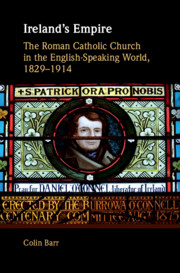37 results
A history of high-power laser research and development in the United Kingdom
- Part of
-
- Journal:
- High Power Laser Science and Engineering / Volume 9 / 2021
- Published online by Cambridge University Press:
- 27 April 2021, e18
-
- Article
-
- You have access
- Open access
- HTML
- Export citation
Chapter 6 - Newman’s Irish University
- from Part II - Ireland and the Liberal Arts and Sciences
-
-
- Book:
- Irish Literature in Transition, 1830–1880
- Published online:
- 29 February 2020
- Print publication:
- 12 March 2020, pp 92-107
-
- Chapter
- Export citation
6 - Australia
-
- Book:
- Ireland's Empire
- Published online:
- 20 December 2019
- Print publication:
- 16 January 2020, pp 281-402
-
- Chapter
- Export citation
Introduction
-
- Book:
- Ireland's Empire
- Published online:
- 20 December 2019
- Print publication:
- 16 January 2020, pp 1-21
-
- Chapter
- Export citation
5 - Canada
-
- Book:
- Ireland's Empire
- Published online:
- 20 December 2019
- Print publication:
- 16 January 2020, pp 204-280
-
- Chapter
- Export citation
Contents
-
- Book:
- Ireland's Empire
- Published online:
- 20 December 2019
- Print publication:
- 16 January 2020, pp vii-vii
-
- Chapter
- Export citation
Bibliography
-
- Book:
- Ireland's Empire
- Published online:
- 20 December 2019
- Print publication:
- 16 January 2020, pp 483-515
-
- Chapter
- Export citation
7 - New Zealand
-
- Book:
- Ireland's Empire
- Published online:
- 20 December 2019
- Print publication:
- 16 January 2020, pp 403-466
-
- Chapter
- Export citation
1 - The United States
-
- Book:
- Ireland's Empire
- Published online:
- 20 December 2019
- Print publication:
- 16 January 2020, pp 22-76
-
- Chapter
- Export citation
4 - South Africa
-
- Book:
- Ireland's Empire
- Published online:
- 20 December 2019
- Print publication:
- 16 January 2020, pp 151-203
-
- Chapter
- Export citation
Copyright page
-
- Book:
- Ireland's Empire
- Published online:
- 20 December 2019
- Print publication:
- 16 January 2020, pp iv-iv
-
- Chapter
- Export citation
Dedication
-
- Book:
- Ireland's Empire
- Published online:
- 20 December 2019
- Print publication:
- 16 January 2020, pp v-vi
-
- Chapter
- Export citation
Index
-
- Book:
- Ireland's Empire
- Published online:
- 20 December 2019
- Print publication:
- 16 January 2020, pp 516-566
-
- Chapter
- Export citation
3 - India
-
- Book:
- Ireland's Empire
- Published online:
- 20 December 2019
- Print publication:
- 16 January 2020, pp 113-150
-
- Chapter
- Export citation
Conclusion
-
- Book:
- Ireland's Empire
- Published online:
- 20 December 2019
- Print publication:
- 16 January 2020, pp 467-482
-
- Chapter
- Export citation
Abbreviations
-
- Book:
- Ireland's Empire
- Published online:
- 20 December 2019
- Print publication:
- 16 January 2020, pp xiv-xvi
-
- Chapter
- Export citation
2 - Newfoundland
-
- Book:
- Ireland's Empire
- Published online:
- 20 December 2019
- Print publication:
- 16 January 2020, pp 77-112
-
- Chapter
- Export citation
Acknowledgements
-
- Book:
- Ireland's Empire
- Published online:
- 20 December 2019
- Print publication:
- 16 January 2020, pp viii-xiii
-
- Chapter
- Export citation

Ireland's Empire
- The Roman Catholic Church in the English-Speaking World, 1829–1914
-
- Published online:
- 20 December 2019
- Print publication:
- 16 January 2020
11 - The Re-energising of Catholicism, 1790–1880
- from Part III - Religion
-
-
- Book:
- The Cambridge History of Ireland
- Published online:
- 20 April 2018
- Print publication:
- 26 April 2018, pp 280-304
-
- Chapter
- Export citation



